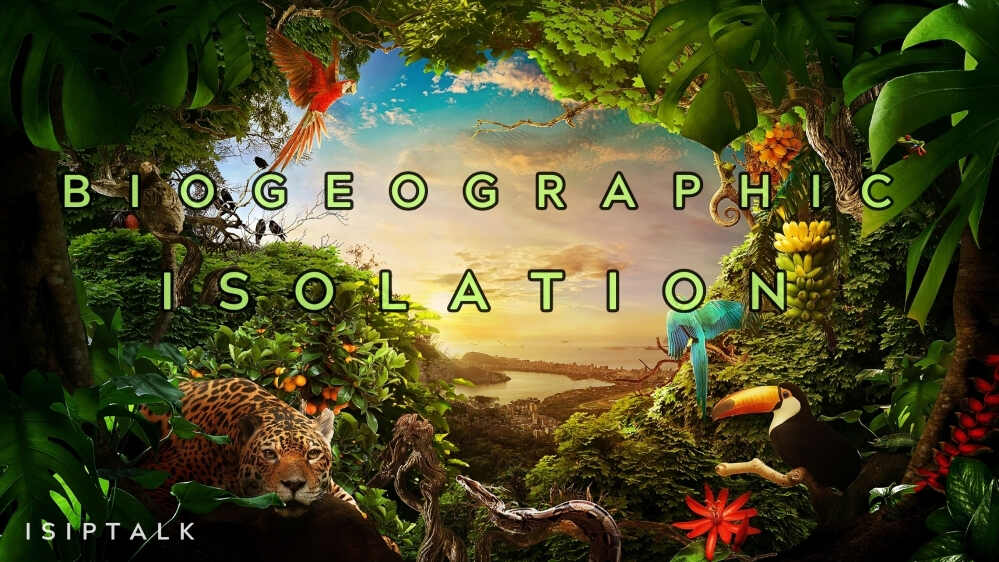Geographic isolation, also known as Biogeographic Isolation, is an important concept in evolution and ecology. It takes place where the population of a certain species is geographically isolated by factors like mountains, rivers, oceans, or distances. This limits the ability of the population to swap genes and in the long run, give rise to the formation of new species. In this article, we will discuss which best describes biogeographic isolation? to explain its roles in evolution and its respective impact on global species distribution.
What is Biogeographic Isolation?
The best describes biogeographic isolation to do with splitting the population of organisms into geographic areas where they cannot communicate or breed. The separation can be caused by natural barriers like:
- Mountains: Mentioning such examples as the Himalayas or the Andes, ranges can separate people.
- Water Bodies: The waters such as oceans, rivers and lakes present physical forms of biogeographical barriers to tetrapods.
- Deserts: Some species adapted to other biomes, for example, the species of the Sahara Desert, can be separated.
- Distance: They also show that vast geographical distances are enough to preclude the populations from being in contact.
How Does Biogeographic Isolation Occur?
Biogeographic Isolation typically occurs through processes like:
a. Tectonics of the Earth’s Crust and the Continental Drift
Transforming movements of the lithosphere apart from people. For instance, when the continents merged into a single supercontinent –Pangaea – species were separated on different continents.
b. Habitat Fragmentation
Some of the actual activities that humans undertake like cutting down trees or constructing buildings seclude people.
c. Natural Disasters
Hurricane, volcanic activities or earthquake activities bring about changes in geography by forming barriers or new islands.
d. Climatic Changes
The changing of climate causes the changes in habitat which as a result affect the population, making them to be confined in different areas due to non availability of the same habitat.
Role of Biogeographic Isolation in Evolution

a. Speciation
Biogeographic isolation becomes very productive in the development of species; in fact, it is one of the principal effects of biogeographic isolation. It simply stated that when populations are part then they are not able to interbreed. Mutations, over a period of some time, in genes and process of natural selection results in fits to the environment. To clarify, where the changes are large, they create new species.
b. Genetic Divergence
Isolated populations undergo one of the other mechanisms of microevolution such as genetic drift in which changes in gene frequencies are random. Such changes result potentially in differential evolution routes being opened up.
c. Adaptive Radiation
In some circumstances, small overcrowded populations develop distinct habitation conditions. This case is called the process of adaptive radiation which describes formation of various species such as the finches of Galápagos Islands.
Examples of Biogeographic Isolation in Nature
a. Galápagos Finches
Today let us look into what was conventionally captured by Charles Darwin: the finches of the Galápagos Islands that had evolved based on their food chain demands. Social isolation on several islands in this picture forced birds to develop different beak morphologies from other birds.
b. Australia’s Unique
Wildlife Due to geographical malaise that spans millions of years it has developed its own kind of animals like kangaroos, koalas, and platypuses which are naturally not found in any other continent.
c. Madagascar’s Lemurs
Some of Madagascar’s unique mammal inhabitants originated from the country, due to its geographical isolation from Africa, including the lemurs.
Human Impact on Biogeographic Isolation
Humans play a dual role in biogeographic isolation:
a. Creating Isolation
Habitat fragmentation due to construction works, deforestation and agriculture may make populations isolated. For instance, constructing highways through the forest disrupts the pathways of animals to move from one place to another.
b. Reducing Isolation
Biological processes for example through transport and direct introduction of invasive species withdraw natural Biogeographical barriers that hitherto kept different population set offs previously isolated. This may cause havoc to any environment and give rise to such problems as erosion of native species.
Biogeographic Isolation and Conservation
Biogeographic isolation is important in the context of conserving extant species in the area. Conservationists can use this knowledge to:
- Protect Isolated Habitats: Thus, it is vital to protect unusual habitats such as islands or solitary woods in order to save endemic populations.
- Restore Connectivity: Wildlife passages may automatically enhance landscape connectivity in ways that potentially enable gene exchange between separated populations.
- Prevent Invasive Species: Controlling the processes by which human beings bring in outside species are also important in maintaining isolative conditions.
Biogeographic Isolation in Current Research
Researchers keep on exploring biogeographic isolation as a way of knowing how it affects species distribution and diversification. Recent advancements include:
- Molecular Genetics: It is possible to determine the phylogenetic history of such a population based on the DNA samples.
- Geographic Information Systems (GIS): GIS technology collects data on the species distribution and recognizes the obstacles.
- Climate Modeling: Forecasting how climate change may introduce or remove geographical boundaries.
Challenges in Understanding Biogeographic Isolation
Studying biogeographic isolation comes with challenges:
- Complex Interactions: So, geographic barriers may not be the only ones involved; ecological, behavioral and genes’ factors matter as well.
- Human Influence: Thus, many natural isolation processes are being influenced by anthropogenic changes.
- Data Gaps: Developing remote areas and people with little number are typically not victims of extensive research.
Conclusion
This has constituted one of the tenets of Neo Darwinian theory in the context of the geographical distribution of species that best describes biogeographic isolation. Through its action of halting gene flow, it promotes speciation and genetic distinctiveness thus yielding new systems and kinds of species. But what is deteriorating is a natural and beautiful process that has been threatened by human interference hence the call for more sustainable practices and conservations.
FAQs
A population that is geographically isolated as a result of barriers like mountains, oceans, or deserts, from another population, is said to be under biogeographic isolation.
When populations are isolated, they evolve independently through genetic changes and adaptations, eventually leading to the formation of new species.
Yes, human activities like deforestation, urbanization, and the construction of roads can fragment habitats and either create or reduce isolation between populations.
An example is the unique wildlife of Australia, where geographic isolation for millions of years led to the evolution of species like kangaroos and koalas that aren’t found naturally elsewhere.
Scientists use molecular genetics, geographic mapping tools like GIS, and climate modeling to study the effects of isolation on species and track how populations evolve over time.
You can also Check Out:






